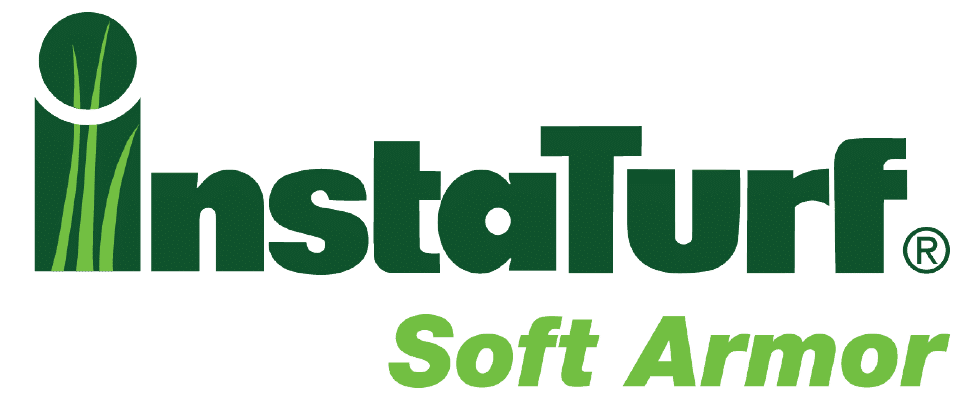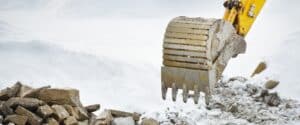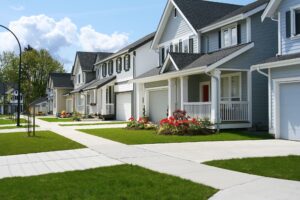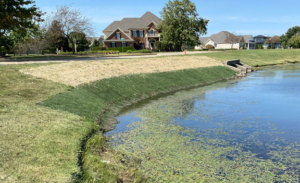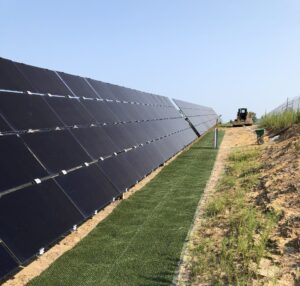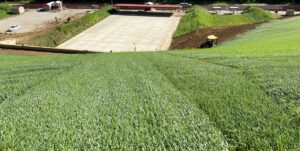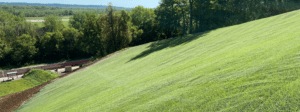It’s natural to plan for shoreline erosion control when you know the shore in question will be impacted by heavy wave action—such as along coast lines or large lakes—but smaller shorelines need to be protected, too. The wave action in a small retention pond, for example, may not appear particularly damaging to the shoreline at any one moment, but even a small pond sees persistent erosion from small waves driven by the wind or in some cases, water fountains and aeration systems. This erosion takes course over time and, without preventative maintenance, leads to soil loss, subsequent vegetation loss, and finally more soil loss due to the ground being unprotected by vegetation. If you’re trying to avoid that vicious cycle, it requires planning, proper maintenance, and an understanding of erosion control materials as well as how those materials work with shoreside vegetation.
Here’s some helpful information on smaller-scale freshwater shorelines and how to protect them with long-term, sustainable, and affordable solutions. Let it serve as a reminder or pass it along to your clients to explain the importance of proper shoreline erosion control.
What Damage Does Shoreline Erosion Cause?

Development along freshwater ponds as well as the construction of new ponds contribute to the vulnerability of freshwater shorelines due to vegetation removal and soil displacement. An unprotected pond or small lake shoreline is especially concerning due to environmental concerns and regulations about sediment and pollutant runoff. Without a proper vegetation buffer, pollutants like heavy metals, agricultural chemicals, assorted waste, and industrial byproducts can be washed into the water unimpeded, wreaking havoc on aquatic ecosystems—which, in turn, affects the terrestrial ecosystem—and potentially incurring heavy environmental fines to the site or business owner.
Severely eroded pond banks cease to be functional for fishing and other recreation. What was once a lakeside fishing spot can turn into an uncomfortable and dangerous falling and/or drowning hazard. Unstable and eroded ground also poses a safety risk for maintenance workers who work in the area. In fact, we’ve seen cases where maintenance workers fall into bodies of water, mower and all, when eroded pond and lake banks collapse.
One immediately apparent effect of shoreline erosion is a reduction in water clarity. Unprotected soil tends to make its way into the water due to erosive forces, literally muddying the waters. This is an unsightly effect; any residents, patrons, or visitors to the pond and surrounding area would be displeased to find that that their lakeshore property is mired in muddy water. In fact, according to a Bemidji State University study on water quality and lakeshore property values, higher water clarity plays a significant positive role in determining lakeshore property prices. Furthermore, the study found that changing the water clarity by just one meter can cause a change in property prices that range from tens of thousands to millions of dollars for each individual lake. These results also reflect other similar studies to suggest that a drop in water quality tends to have more severe results on economic value than an increase of water quality, further reinforcing the need for properly planned erosion control products and/or vegetative buffers.
Hard Armor vs. Soft Armor: Which is Best?
There are two main schools of thought when it comes to pond shoreline erosion protection: hard armoring and soft armoring. Hard armoring covers the use of hard materials such as rock, concrete, and sometimes wood or metal to retain banks and hold soil. This is a useful technique in steep and/or high wave action applications where live vegetation is too fragile for the task. Hard armoring has its uses—it’s instant and it’s usually reliable when installed properly—but hard armor is generally not people friendly, it discourages the growth of natural vegetation, increases surface and water temperatures, and requires heavy equipment to transport and install.
On the other hand, soft armoring is the use of natural vegetation to protect the shoreline. Because heavy materials aren’t needed, soft armoring is typically less equipment-intensive and more labor intensive than hard armor solutions. Soft armoring integrates native plants so the protected area blends in seamlessly with the surrounding ecosystem. A proper vegetative buffer can also more effectively filter and trap pollutants and sediment before they reach the water. In short, soft armoring is often the preferred soil protection for freshwater pond and small lake shorelines.
However, natural, unreinforced vegetation can only withstand so much wave action in terms of size and frequency, and the realities of time constraints, budgets, and site geography often push engineers to pursue quicker means of permanent soil protection like hard armor.
Vegetation Protects Shorelines

Vegetation that is planted or purposefully left in place next to a water body to serve as a barrier against sediment and other pollutants is called a “vegetative shoreline buffer” or “filter strip” for that body of water. Given enough time and the processes of nature, native shoreline plants would likely crop up in and next to the body of water naturally, but it’s generally not feasible to wait for a protected shoreline and an improvement in water quality. Soil loss can occur deceptively quickly and can change your shoreline for the worse, causing it to be undercut, encroach on dry land, or otherwise destabilize—not to mention the drop in water quality an unprotected shoreline causes. As noted above, it’s much more impactful on economic value to see a drop in water quality—so the price paid for a piece of land is at risk of devaluing sharply unless water quality is considered throughout whatever construction or conservation projects occur on that piece of land.
But how exactly does vegetation protect shorelines? Local flora protects the land in several ways:
• Trees, shrubs, and undergrowth work to lessen the impact of rainfall and guide water down stems and trunks to the ground.
• Leaf litter or ground covers keep soil in place and prevent particles from being transported away in wet conditions.
• Deep layers of decomposing leaves or thick patches of meadow grasses serve as barriers to slow water velocity, collecting runoff and preventing erosion from mild to moderate wave action.
• Earthworms and roots of plants make the ground more porous, preventing soil loss and runoff as above, while also making the ground more likely to saturate with groundwater, giving plants a healthy reserve of moisture.
• This porous ground also allows excess nutrients to saturate the soil before reaching the body of water, nourishing land plants while preventing an excess of aquatic nutrients which can lead to an algae bloom
• Porous ground means pollutants such as heavy metals can become trapped in the soil rather than reaching the water source. This is generally preferable to the pollutants reaching the water, particularly if the body of water is a stream or river where contamination can spread easily.
• Vegetation roots simply bind and stabilize soil so it isn’t eroded and washed away.
When establishing a protective buffer to protect shorelines and improve water quality, it may seem sufficient to plant turf grass. Or perhaps turf grass is already grown in on your site. Turf grasses typically don’t penetrate their roots very far into the soil, thereby providing minimal shoreline protection when compared to a well-rounded buffer zone with a variety of native plants. In fact, many shorelines are undercut and unstable due to erosive forces cutting underneath shallow turf grass roots. As noted previously, grasses without some form of reinforcement have limited ability to resist substantial and/or frequent wave action.
Turf grasses are certainly better than nothing when it comes to reducing water pollutants and protecting soil, but a long-lasting and effective shoreline buffer will ideally include everything from aquatic plants like reeds in the shallows, herbaceous cover at and above the water line, and woody plants further out to fill in the space. Aquatic plants in particular help to slow waves before they reach the shore, preventing the undercutting typically associated with shorelines protected mainly by turf grasses. Unfortunately, many commercial/residential developments use only turf grasses as their preferred vegetation, running the risk of undercutting and other soil loss.
Buffer zones should be as wide as possible and include a wide range of mostly native plants and few if any non-native species. Most shorelines fluctuate in height. If you’re concerned about whether to plant aquatic or terrestrial vegetation on a fluctuating shoreline, a good way to hedge your bet is to plant a mixture of wet- and dry-adapted species. Over time, the more suitable plants will survive and propagate.
The Three Zone System

A useful heuristic has been developed for riparian forest buffers to separate the planting areas into three zones.
• Zone 1 includes the edge of the shoreline and should ideally include aquatic plants, shade-giving trees, and other shrubs or herbaceous plants with deep roots to protect the shoreline.
• Zone 2 is ideally composed of native shrubs a bit further from the shore to shelter wildlife and filter contaminants not filtered by zone 3.
• Zone 3 is further inland and includes mainly native grasses to absorb contaminants.
Zones 2 and 3 do the bulk of the sediment and pollutant filtering accomplished by a riparian buffer. By the time runoff reaches zone 1, it should be effectively filtered of contaminants and sediment—the main objective of plants in zone 1 is to protect the shoreline.
Zone 1 is where most of your planning comes in when it comes to smaller-scale pond buffers. It’s typically unfeasible to plant large trees for shade, and many sites already have a well-developed forest or grassland that backs up into the shoreline. Shrubs and reed-like plants can be planted in zone 1 to protect your pond shoreline more quickly than large trees can grow. Of course, overseeding with native seeds is one option, but it takes time for plants to grow from seed to the point where they provide soil protection.
As you can see, shoreline buffers require a good deal of planning if they’re going to be successful, sustainable, and self-sufficient. Refer to this document by the United States Department of Agriculture for a set of best practices when it comes to riparian forest buffers.
Pond Vegetative Shoreline Buffer Maintenance

Native vegetation buffers really shine once they become more-or-less self-sufficient. That’s one reason native plants are desirable. If planned, installed, and maintained properly, native vegetation buffers can work harmoniously with the surrounding environment to maintain high water quality and healthy flora and fauna.
Upon installation of a vegetative buffer, the first year should be spent removing invasive weeds that compete with your chosen flora. In subsequent years, native vegetation should be dominant enough that weeding is required less often. Similarly, watering is important especially early on and during hot and dry periods, but the need to water your buffer will decrease as plants establish and reach a balance in their environment, utilizing the body of water itself for moisture.
If possible, it’s best to avoid the use of fertilizers and pesticides entirely as these pose the very risks to your pond’s water quality that a vegetative shoreline buffer is designed to mitigate.
InstaTurf ShearForce Products: The New Solution for Quicker, More Effective Permanent Vegetative Buffers
The realities of a project often preclude the use of native vegetative buffers, even in small freshwater pond applications. It is often advised to choose hard armor shoreline protection because temporary erosion control blankets (ECBs), or where needed, permanent turf reinforcement mats (TRMs), have limited erosion resistance under wave action prior to vegetation establishment. Engineers and contractors don’t want to risk their reputation on ECBs or TRMs that are at a significantly increased risk of failure under wave action for the first 6-12+ months after installation. These materials just don’t offer much erosion resistance against wave impact, allowing underlying soil and seed to be washed away by lapping waves.
InstaTurf ShearForce products represent a new path when it comes to small-scale shoreline protection: the immediate soil protection and reliability of hard armor materials, coupled with the ability to allow natural vegetation to grow through to form a permanently reinforced vegetative shoreline buffer. Even though InstaTurf ShearForce products are lightweight like traditional TRMs, they can actually provide the same soil protection as 30-inch rock riprap from day one. And, ShearForce products stay in place to double the long-term erosion resistance of the natural vegetation growing through them, forming a permanent vegetative armoring system that won’t wash out. The simulated turf structure on InstaTurf ShearForce products protects the soil by raising the hydraulic shear plane above the soil while an integrated geotextile fabric retains soil. The product also immediately acts as a filter to catch sediments and pollutants before they enter the waterbody, and this ability only increases as vegetation fills in.
While InstaTurf ShearForce products mimic turf grass and allow natural turf grass to grow through unimpeded, other plant species can grow through the simulated turf as well. If planting from seed, we’ve seen the successful use of native vegetation seed mixes that include aquatic/riparian species. Simply apply seed before and/or after installation and watch native plants grow up or root down through the turf. Alternatively, planting tubers and seedlings is as easy as cutting a slit in the mat and planting through it. Even woody plants and saplings can be planted through InstaTurf by simply cutting an “X” in the mat and planting normally.
Maintenance is simple with InstaTurf ShearForce products as well. Unlike hard armor products, you can easily and safely walk on and mow over InstaTurf as needed. InstaTurf is a permanent solution, so once plants grow in to form a healthy buffer, no further work is necessary aside from your regular weeding/mowing schedule.
If you want to learn more about InstaTurf ShearForce products, read more about shoreline applications here.
